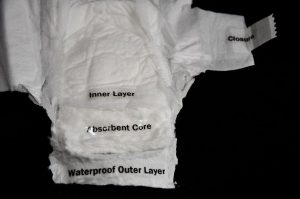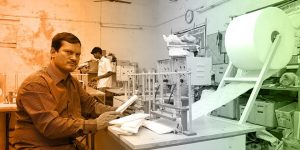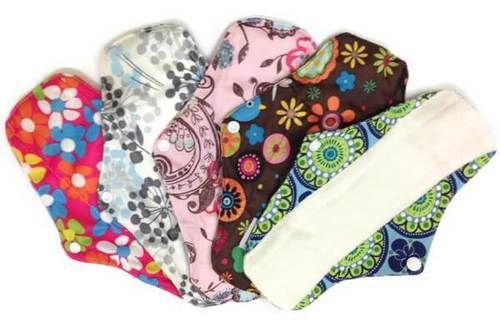Every morning, you keep your dustbins outside, the cleaning staff comes and collects the garbage.
Ever wondered where all this trash goes? In many cases, the diligent sanitation workers will have to manually separate the garbage, while being at risk of infection themselves. While some of this waste can be composted or recycled, what happens to the used diapers, sanitary napkins, or waste containing bodily fluids?
Every year, India generates 113,000 tonnes of sanitary waste, as per the latest government data.
The mountain of menace

Image source: click here
All this waste goes for either thermal processing (incinerators) or bioprocessing (composting). The residue is dumped in sanitary landfills, creating a pile of non-biodegradable materials.
In addition to disposable diapers that contain toxic chemicals, a majority of this pile comprises of menstrual waste – waste from disposable sanitary pads. While being a convenient choice for urban women, these disposable pads are not only a potential health hazard but are also a menace to the environment.

Image source: click here
What’s inside a disposable pad

Image source: click here
A lot of women might not be aware of the number of toxic chemicals and plastics an average disposable pad contains. For quicker absorption, a layer of SAPs (Super Absorbent Polymers) is present along with dioxins that bleach the cotton or the cheaper wood pulp used in the center. Rayon and silicone make the outer sheet. Add to these furans and other pesticides, deodorants, adhesives – and we’ve got a product with a host of health risks, and taking hundreds of years to decompose. Cutting several trees to get the wood pulp and raw materials used is another story.
Processing of the waste
The Solid Waste Management (SWM) Rules classify disposable pads as domestic hazardous waste or sanitary waste. Managing such waste would include
- Segregation at source: Citizens to throw such garbage in separate bags
- Manufacturers of these pads to provide wrappers for safe disposal
- Rules for safe treatment of the waste in all open dumpsites
In 2018, CPCB (Central Pollution Control board) issued detailed guidelines for the disposal of different kinds of sanitary waste.
Even with all these rules, implementing a viable model for managing menstrual waste on a countrywide scale is still far from reality. Waste management rules vary from state to state and are enforced by local authorities. Limited resources and operational capacities make it difficult for low-income cities to address these challenges. Combined with a lack of awareness about waste management, pollution in rural areas often goes unchecked.
While manufacturers of disposable pads can get away with only providing a wrapper, organizations are taking initiatives to spread awareness about separating menstrual waste from household garbage.
At many places, these pads are burned in incinerators (with regulated temperature and pressure and control gas emissions). The process can emit dangerous gases that can be carcinogenic.
What about rural India?
Now, how do you think is the situation in rural India? There, a large percentage of women do not even have access to sanitary products, making them resort to dirty rags, husk, and other unhygienic options. Those who have benefitted from the distribution of low-cost napkins (by governments, schools, or Accredited Social Health activists) mostly receive disposable pads and are given little or no education about the safe disposal of these products.

They end up either throwing these pads in open spaces, burying or burning them in an unregulated manner, putting the environment and public health at risk.
Though things are changing, social stigmas and taboos around menstruation still linger in our society. This shame and awkwardness only make it harder for women to come forward and demand a mechanism for safe disposal of sanitary waste.
Sounds like a problem? It is. The sooner we collectively resolve it, the better it is for our future.
The right way Forward
Sustainability
But what is the way forward to coming out of this crisis? Will implementing waste management policies be enough? More importantly, in a populous country like ours, will it be easy and quick?
There has to be another solution. Instead of relying on policies and rules for handling disposable products, what if focus on reducing the non-degradable waste first?
By using reusable sanitary products – cloth sanitary pads, cloth diapers, menstrual cups, etc. we can significantly reduce the environmental pollution caused by plastic and chemical-containing disposable products.
Reusable solutions
Today, social entrepreneurs, NGOs, and other organizations are coming up with good quality cloth sanitary pads with absorbent but environment-friendly materials like cotton, banana fiber, etc. These pads can be washed and dried. Properly maintained, these pads can last from 3 to 5 years.
With the governments and NGOs focusing on rural women and girls in schools who do not have access to sanitary products, this can be an opportunity to promote environment-friendly alternatives.
Apart from these, options like menstrual cups (made of medical-grade silicone) and other products are also getting increasingly popular among urban women.
Research is also underway by government departments to come up with more cost-effective and recyclable or bio-degradable sanitary products that are also scalable.

Image source: click here
Conclusion
In a large country like India, the waste produced by disposable sanitary products can be a threat to the environment, besides being a public health risk, due to their non-degradable nature.
Along with effective waste management techniques, widespread awareness about the safe disposal of waste will help address this challenge.
Switching to reusable and sustainable products can avoid environmental pollution.

